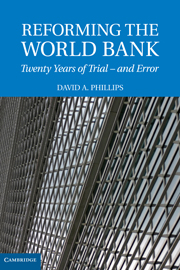Book contents
- Frontmatter
- Contents
- Preface: The Search for Effectiveness in the World's Premier Development Institution
- REFORMING THE WORLD BANK
- PART I ORIGINS AND EVOLUTION
- PART II THE SEARCH FOR EFFECTIVENESS
- 3 Fifty Years of Bank Reforms
- 4 The 1990s – Re-Engineering the Organization
- 5 Changing Culture and Changing People
- 6 Reforming the Bank's Assistance Product
- 7 Changing the Quality of Development Assistance
- 8 Financing the Reorganization
- 9 Why Did the Reforms Fail?
- PART III TOWARDS REAL REFORM: THE GOVERNANCE AGENDA
- Index
8 - Financing the Reorganization
Published online by Cambridge University Press: 25 January 2011
- Frontmatter
- Contents
- Preface: The Search for Effectiveness in the World's Premier Development Institution
- REFORMING THE WORLD BANK
- PART I ORIGINS AND EVOLUTION
- PART II THE SEARCH FOR EFFECTIVENESS
- 3 Fifty Years of Bank Reforms
- 4 The 1990s – Re-Engineering the Organization
- 5 Changing Culture and Changing People
- 6 Reforming the Bank's Assistance Product
- 7 Changing the Quality of Development Assistance
- 8 Financing the Reorganization
- 9 Why Did the Reforms Fail?
- PART III TOWARDS REAL REFORM: THE GOVERNANCE AGENDA
- Index
Summary
The finances of the Bank came under a number of pressures during the reorganization period. First of all, the Strategic Compact itself set aside some $570 million for the Bank's reorganization over three years, including $420 million for re-engineering (less $170 million in expected savings) and $150 million for redundancies. At the same time the reorganization period saw a rise followed by a steep decline in total lending that has been maintained since, a shift in the structure of lending away from income-generating large loans to small, loss-making knowledge products, and finally an increase in administrative costs. Prima facie these changes would have been expected to create pressures on the Bank's net income, on its financial sustainability, and on its operational independence. How far was the Bank able to manage these pressures?
LENDING FALTERS
A potential decline in IBRD lending, due partly to high transaction costs, was one of the principal concerns aired in the Strategic Compact. As shown inFigure 8, a plateauing in lending volume occurred in 1996, and this was the source of the Compact's concern. But the onset of the Asian economic crisis for a time obscured the problem, as the growth of new lending approved by the IBRD recovered and rose to a record in 1999 of $22 billion. Thus the Compact was agreed on, by chance, just prior to a peak in lending.
- Type
- Chapter
- Information
- Reforming the World BankTwenty Years of Trial - and Error, pp. 192 - 209Publisher: Cambridge University PressPrint publication year: 2009

